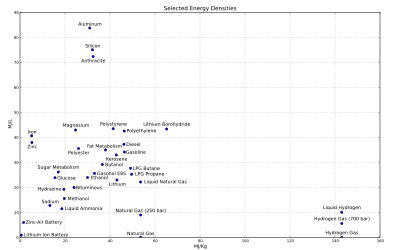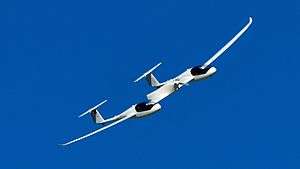Hydrogen-powered aircraft
A hydrogen-powered aircraft is an aeroplane that uses hydrogen fuel as a power source. Hydrogen can either be burned in some kind of jet engine, or other kind of internal combustion engine, or can be used to power a fuel cell to generate electricity to power a propeller.
Unlike most aircraft, which use wings for storing fuel, hydrogen aircraft are usually designed with the liquid hydrogen fuel carried inside the fuselage, in order to minimize surface-area and reduce boil-off.
According to research at the Pennsylvania State University in 2006, large commercial hydrogen aircraft could be built by 2020 but "will probably not enter service until closer to 2040."[2]
The European Union's research project in cooperation with Airbus and 34 other partner companies dubbed CRYOPLANE assessed the technical feasibility, safety, environmental compatibility and economic viability of using liquid hydrogen as an aviation fuel. This was concluded in 2002 (with the final report published in 2003).[3]
Properties of hydrogen

Being an alternative to traditional jet fuel, hydrogen has a higher energy density per unit mass but a lower energy density per unit volume, and containing the hydrogen at high pressure would require a heavy container. In aircraft heavy containers are not an option, and therefore regular carbon fibre tanks are often used, which can only sustain a pressure of about 350 bar. This is significantly lower compared to steel hydrogen containers (used in cars and ships) which can sustain 500 to 700 bar. This limitation decreases the amount of energy that can be spent on the propulsion by about half.[4] Alternatively, as with some rockets, cryogenic liquid hydrogen could be employed.
If hydrogen were available in quantity from non-emitting energy sources, such as wind or nuclear, its use in aircraft would produce fewer greenhouse gases (water vapor and a small amount of nitrogen oxide) than current aircraft. Currently, however, very little hydrogen is produced using renewable energy sources, and there are several serious obstacles to the use of hydrogen in aircraft and other vehicles.[5] Due to the way it is produced, and the relative inefficiencies of its production given current technology, hydrogen is a much more expensive fuel than fossil fuels.
Liquid hydrogen is one of the best coolants used in engineering, and it has been proposed to use this property for cooling intake air for very high speed aircraft, or even for cooling the vehicle's skin itself particularly for scramjet-powered aircraft.
Properties of hydrogen aircraft
Liquid hydrogen has about four times the volume for the same amount of energy of kerosene based jet-fuel. In addition, its highly volatile nature precludes storing the fuel in the wings, as with conventional transport aircraft. Therefore, most liquid hydrogen aircraft designs store the fuel in the fuselage, leading to a larger fuselage length and diameter than a conventional kerosene fuelled aircraft. This lowers the performance due to the extra wetted area of the fuselage. The larger fuselage size causes more skin friction drag and wave drag. On the other hand, hydrogen is about one-third of the weight of kerosene jet-fuel for the same amount of energy. This means that for the same range and performance (ignoring the effect of volume), the hydrogen aircraft would have about one-third of the fuel weight. For a Boeing 747-400 type aircraft, this would reduce the takeoff gross weight from 360,000 to 270,000 kg (800,000 to 600,000 lb). Thus, the performance of a hydrogen-fueled aircraft is a trade-off of the larger wetted area and lower fuel weight. This trade-off depends essentially on the size of the aircraft.
Prototypes
The Russian manufacturer Tupolev built a prototype hydrogen-powered version of the Tu-154 airliner, named the Tu-155, which made its first flight in 1989.[6] This was the first experimental aircraft in the world operating on liquid hydrogen.

Boeing Research & Technology Europe (BR&TE) made a civilian aircraft from a 2-seat Diamond Aircraft Industries DA20 running on a fuel cell (called Theator Airplane)".The German aerospace center and[7][8] Lange Aviation GmbH also made a hydrogen-powered aeroplane with its Antares DLR-H2 airplane.[9] These aircraft are of course configured in such fashion that the current low energy output from hydrogen propulsion (a result of the low-pressure hydrogen tanks) do not pose a problem. For example, the Boeing Theator airplane only required 45 kW to take off, and 20 kW to stay airborne. In July 2010 Boeing also unveiled its hydrogen powered Phantom Eye UAV, that uses two Ford Motor Company internal combustion engines converted to operate on hydrogen.[10]
In 2010 Rapid 200-FC, the first airplane in Europe and in the World fueled by gaseous hydrogen, successfully concluded six flight tests. According to FAI Sporting Code, the airplane is considered in Class C while motor-gliders (such as Boeing R&T Diamond DA20 and Antares DLR-H2 projects) are considered Class D. The aircraft and the electric and energy system was developed within the European Union's "ENFICA-FC" project (Environmentally Friendly Inter City Aircraft powered by Fuel Cells) coordinated by Prof. Giulio Romeo of the Politecnico di Torino.[11][12] The completely electrical power system was successfully tested during the experimental flight. The rotation speed of 84 km/h has been obtained within 184 m of taxi at power of 35 kW. After take-off, speed was than increased up to indicated values of 110-120 km/h. Level flight at 700ft and 130 km/h was attained by mean of only fuel cell power setting. A new speed record of 135 km/h (flown of 4 consecutive runs over a 3 km course - according to FAI Sporting Code, Class C Aeroplanes) was established. Also several higher speed at 145-150 km/h for tens of seconds were measured during free flights. The flights reached an endurance of 45 minutes. The aircraft has an entirely electric 40 kW propeller; power is supplied to the propeller through 20 kW fuel cells fueled by hydrogen gas stored at 350 bar. In order to guarantee absolute safety of the operations, the airplane also has a second source of energy that consists of a set of 20 kW lithium polymer batteries which are able to guarantee alternative or supplementary power during take-off.
In 2011, an AeroVironment Global Observer which was fitted with a hydrogen-fueled propulsion system.[13]
HY4 became the world's first passenger aircraft with an engine powered by a hydrogen fuel cell. Its first flight took place in Stuttgart airport, Germany, on September 29, 2016.[14] It has 9 kg hydrogen, 4x11 kW fuel cells and 2x20 kWh batteries.[15]
Proposed hydrogen aircraft
Historical
- Lockheed CL-400 Suntan 1950's concept liquid hydrogen aircraft that was dropped in favour of the SR-71
- Liquid hydrogen was proposed for use on the scramjet-based National Aerospace Plane.
- AeroVironment Global Observer
Current
- Reaction Engines Skylon orbital hydrogen fuelled jet plane
- Reaction Engines A2 antipodal hypersonic jet airliner
- DLR Smartfish
- Boeing Phantom Eye
See also
References
- ↑ Robertson, David (2008-04-03). "Boeing tests first hydrogen powered plane". London: The Times.
- ↑ Maniaci, David C. "Operational Performance Prediction of a Hydrogen-Fueled Commercial Transport" 2006 symposium paper Archived 2006-09-05 at the Wayback Machine.
- ↑ Airbus Deutschland "Liquid Hydrogen Fuelled Aircraft - CRYOPLANE Final Technical Report" 2003
- ↑ Eos magazine, vliegen op waterstof, July–August 2008
- ↑ "Hydrogen aircraft". H2 Vehicles. Archived from the original on 2012-06-18. Retrieved 2016-05-06.
- ↑ Tupolev.ru Archived 2010-11-26 at the Wayback Machine.
- ↑ Boeing Fuel cell airplane article 1 Archived 2009-07-27 at the Wayback Machine.
- ↑ Boeing Fuel cell airplane article 2
- ↑ Lange Aviation Antares DLR-H2 Archived 2009-07-23 at the Wayback Machine.
- ↑ "Boeing's 'Phantom Eye' Ford Fusion powered stratocraft". The Register. 2010-07-13. Retrieved 2016-10-19.
- ↑ Rapid 200-FC
- ↑ Rapid 200-FC by ENFICA-FC
- ↑ Global Observer converted to run on hydrogen
- ↑ "Fuel cell aircraft HY4 makes maiden flight". The Engineer. 2016-09-30. Retrieved 2016-10-19.
- ↑ "Vil ha kortdistanse flytrafikk over på hydrogen". Teknisk Ukeblad. 21 June 2017. Retrieved 21 June 2017.